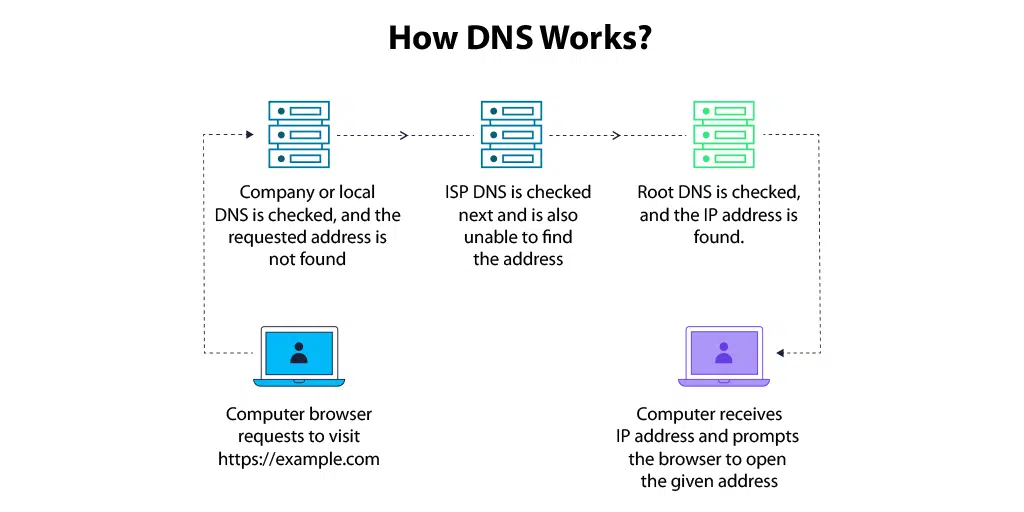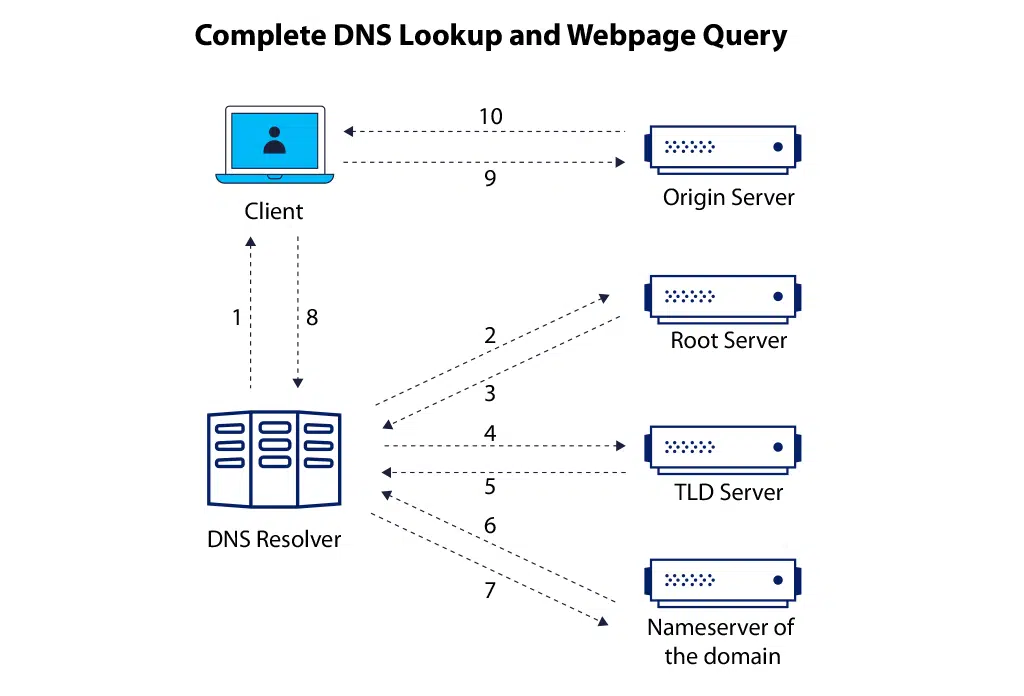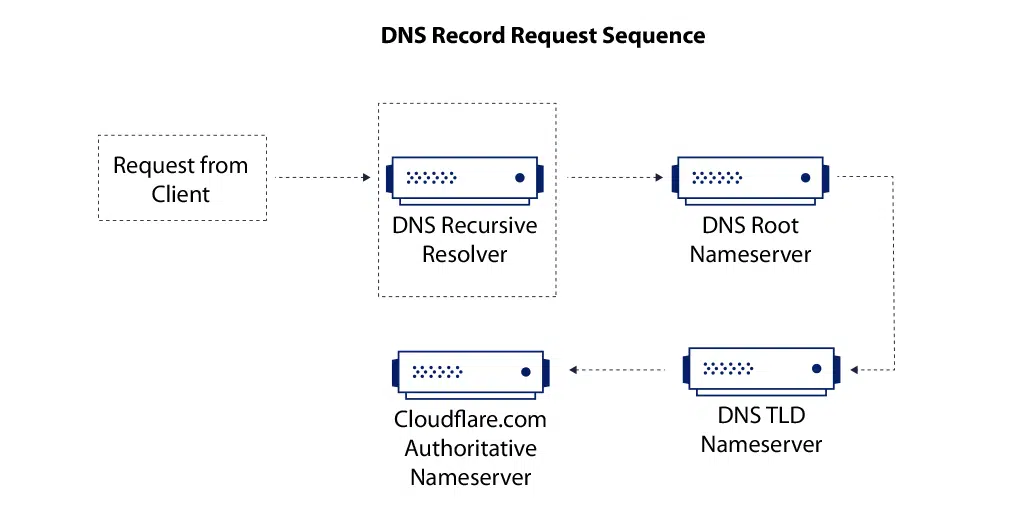Have you ever wondered what is a DNS? How does entering a domain name in a web browser lead to the opening of a specific website? Have you ever come across the term DNS and wondered how domain names work? Let’s have a look at how the system works.

What is a DNS?
Domain Name System (DNS) is a protocol under which a domain address is converted into an IP address and redirects the browser to a particular web server where the website files are hosted. This server then returns the requested web page and displays it in your device’s browser. A domain name system can also be termed a Directory of the Internet, where it searches for the IP address associated with the specific domain name. Each device connected to the internet has a unique IP address, using which other machines communicate with it.
You can read about common errors like DNS_PROBE_FINISHED_NXDOMAIN, 502 Bad Gateway error, 504 Timeout, HTTP Status Code List
In this article, we will cover the following topics –
How does DNS work? (A basic Step by Step Process)
Now you are familiar with some of the technical terms associated with DNS. It is time for you to learn the complete process of DNS step by step.
The DNS server’s basic work is to convert human-readable URLs into IP addresses for computers to understand and find a webpage.
This particular URL into the IP address translation process as well as the lookup of the corresponding webpage termed as DNS resolution.
Step 1: When you enter the URL or domain name of the website into a browser, the browser sends a message i.e. recursive DNS query to the network, To search and find out which IP address the domain name belongs to.
Step 2: This particular recursive DNS query is received by a recursive DNS server also known as a recursive resolver that your ISP generally manages. If this recursive resolver has the website’s address, the website will load instantly.
Step 3: If the recursive resolver does not find the website’s address, it will send messages to other servers in the following hierarchy: DNS root name servers > TLD or Top-level domain name servers > authoritative name servers.
Step 4: These three types of servers work simultaneously until they are not able to get back a DNS record that has the website’s IP address. If found, the information will be sent to the recursive DNS server and the webpage will start loading. The server types, DNS root name server, and TLD servers generally help in redirecting the queries rather than providing resolution.
Step 5: Here the recursive server tends to store A record that contains the IP address of the website in the cache so that when it receives the same request for the same website again, it can directly respond rather than going through all the query processes through server types.
Step 6: In case the other server types unable to find the domain’s address and the request reaches the authoritative server and is still not able to find the information. It will return an error message such as 404 error not found.
The above step-by-step process takes merely milliseconds and also unnoticed by anyone.
DNS servers involved in loading a webpage
About four DNS servers are working together to search and locate the IP address and load the webpage.
- Local DNS Resolver:
- When you enter a domain into your web browser, the first DNS server involved in the process is the Local DNS resolver.
- It is somewhat like a librarian whose main work is to find a specific book from the library.
- It is specially designed to receive requests from web applications such as web browsers also cache the results to speed up future requests.
- If the requested query about the domain is already available in the cache, it will directly load the webpage rather their proceeding further to other DNS servers.
- Root DNS Server:
- If the local DNS resolver doesn’t have the requested domain’s IP address in its cache, it queries the root DNS server.
- This particular server is responsible for doing the translation work. From human-readable domains to IP addresses.
- It is an analogy to an index in a library that points to different racks of books.
- The root DNS server provides information about the top-level domain (TLD) servers.
- TLD DNS Server:
- Based on the TLD of the requested domain (e.g., .com, .org), the local DNS resolver then queries the TLD DNS server.
- The TLD DNS server provides information about the authoritative name server for the specific domain.
- It can thought of particular rack of books in a library.
- For example, if you are looking for example.com, the TLD DNS server for “.com” would provide information about the authoritative name server for “example.com.”
- Authoritative DNS Server:
- The authoritative DNS server is responsible for storing the DNS records for a specific domain.
- The TLD DNS server directs the local DNS resolver to the authoritative DNS server for the requested domain.
- The authoritative DNS server provides the IP address associated with the requested domain.

Authoritative DNS Servers vs. Recursive DNS Servers: Comparison
The Authoritative DNS Servers and Recursive DNS Servers are both integral parts of DNS infrastructure. However, they possess different roles and are also located at different positions in the path of DNS query.
The Authoritative DNS servers are located at the end path of the DNS query, whereas the recursive DNS Servers are at the beginning.
| Feature | Authoritative DNS Servers | Recursive DNS Servers |
|---|---|---|
| Function | Provides authoritative information about domain names, such as IP addresses and other DNS records. | Resolves domain names on behalf of end-users by querying authoritative DNS servers. |
| Responsibility | Holds and manages the DNS records for a specific domain or zone. | Queries authoritative DNS servers to obtain the requested information on behalf of clients. |
| Queries Direction | Responds to DNS queries. | Initiates DNS queries. |
| Example Usage | Hosting providers, domain registrars, and organizations managing their domains. | Internet Service Providers (ISPs), DNS resolver services (e.g., Google DNS, OpenDNS). |
| Caching | May implement caching, but caching is typically minimal or unnecessary. | Implements extensive caching to store previously resolved DNS records, reducing response times. |
| Zone Transfer | Supports zone transfers to synchronize DNS records with secondary authoritative servers. | Does not perform zone transfers; focuses on resolving individual queries. |
| Record Types | Manages various DNS record types (A, AAAA, MX, etc.) for the associated domain. | Primarily concerned with A (IPv4 address) and AAAA (IPv6 address) records, but can handle various types. |
| Security Concerns | Requires secure configuration to prevent unauthorized changes to DNS records. | Vulnerable to cache poisoning and other attacks. Requires security measures to ensure integrity. |
| Examples | BIND, Microsoft DNS, NSD. | Unbound, BIND (recursive mode), Google Public DNS, OpenDNS. |
Read: 🚩 chrome://net-internals/#dns – How to Clear DNS Cache Chrome
What is a DNS resolver?
DNS resolver is one of the very important components of DNS, whose main function is to convert human-readable domain names into corresponding IP addresses. This process of converting or translating a domain name to an IP address is termed DNS resolution.
It is the first step involved in the DNS lookup and mostly deals with the client that makes a request.
This is how it happens, when you enter a domain into the web browser, the resolver sends a query to find the corresponding IP address. Learn more in the step-by-step process of DNS resolver given below.
- Initiation: When you enter a domain name into the browser, the resolver initiates a DNS query.
- Querying DNS Servers: The resolver will first check its local cache whether it has already stored the IP address for the requested domain. If it is not there, it will proceed further to contact a series of DNS servers to gather the information.
- Recursive Query: The resolver typically starts by querying a recursive DNS server. Recursive DNS servers are responsible for navigating the DNS hierarchy and finding the authoritative DNS server for the requested domain.
Here you might get confused between recursive Query and Recursive DNS resolver. The recursive query refers to the request made by the client such as the user’s computer to the DNS resolver asking for the DNS information and expects complete resolution.

Whereas, the DNS recursive resolver is like a server that finds and fetches the necessary DNS information to complete the resolution process.
- Authoritative Query: After that the recursive DNS server will in turn query authoritative DNS servers to get the particular IP address corresponding to the requested domain.
- Caching: Once the IP address is fetched, it is stored in the resolver’s cache for a certain period. This mechanism is very helpful in reducing the time to resolve subsequent queries for the same domain again and again and hence improves efficiency.
- Response: At last, the resolver returns the IP address to the requested application and allows it to establish a connection with the server or resource.
Types of DNS queries
There are three main types of DNS queries,
- Recursive Query: In this particular query, a client i.e. DNS resolver requests information and expects a complete resolution. The resolver has to contact other DNS servers including authoritative DNS servers to fetch the final answer. The complete process flows through a hierarchy of DNS servers until it gets the requested information.
- Iterative Query: In this particular query, the DNS server responds with whatever information it has available at that instant. In case the information provided is not complete, it will point to another DNS server that can provide more information.
- Non-recursive query: When a query or request is made by a DNS client to a DNS server with a condition that the server should not continue resolution further on behalf of the client. The server either has the complete answer or responds with a referral to another server without attempting to resolve the query recursively.
What is DNS Caching?
Just like the browsers have the feature to save cookies and website data in the form of a cache, it also stores DNS records in the cache. You also might be surprised to know that even your OS (Operating System) has the feature to store DNS records for a while.
It’s like your computer saying,” OH, I have looked up the website that you might have visited recently. I’ll store or remember the address for a while in case you visit the website again.”
This DNS caching feature helps to improve speed up your internet browsing experience and enhance efficiency.
Read: 🚩 How to Reduce DNS Lookups and Speed Them Up?
Overall, we can say the main purpose of DNS caching is to reduce the time to get the response of a DNS query. This helps DNS to save all the answers to previous queries closer to the clients and provide the same answers to them instantly the next time it is queried.
DNS records or data can be cached majorly at the following places:
- Browser: Modern Browers are the first place, where DNS records get cached. All the popular browsers such as Safari, Chrome, and Mozilla have the default feature of caching the data for a specific period.
- Operating system (OS): Even your OS has built-in DNS resolvers also called stub resolvers that store DNS records and are supposed to handle all the queries before moving forward to an external server. These come in second place after browsers that queried.
- Recursive resolver: Whenever a client wants to access a website, it asks for a DNS resolver first. Instead of searching for answers from the scratch. The DNS resolver is pretty clever and stores these previous DNS records in the cache on the DNS recursive resolver for a little while.
However, sometimes this caching feature can also be dangerous, to learn more check out our detailed post on “What is a DNS Poisoning aka DNS Spoofing: Meaning, Prevention, and Fix“.
Read: 🚩 How To Fix DNS_PROBE_FINISHED_NXDOMAIN Error?
Some Detailed Technical Overview associated with DNS
The domain name system consists of five interconnected elements, namely:
1. Domain Name
It is the business identity and is based on the preferred choice of the website owner. A website owner can register any of the available domain names, followed by domain extensions, like .com, .net, .co, .org, and .edu. Each of these domain extensions is used for specific purposes.
Under the domain settings within the registrar account, you can set specific Nameservers to point the domain to a specific hosting server.
2. Hosting Server
It is that part of the system where files and databases associated with the website are stored. The hosting service provider provides users with a set of DNS records and Nameservers. You have to specify these nameservers or the DNS records for your domain to direct the end-users to display the webpage on their browser.
If you are a WPOven’s Managed WordPress VPS hosting user, you don’t have anything to worry about, We give free WordPress Development and Server Support to all our users with plans starting at just $66.63. You also get free SSL, SSD Storage, business email, site backup, daily malware scanning and cleanup, etc.
3. Nameservers
It is a sort of directory that keeps the record of all DNS values. So, if you set a specific Nameserver for a domain, it will by default set all the DNS values to that particular server. There are various types of DNS values for different purposes, as discussed in the next section.
4. Some Common Domain Name System (DNS) Records
There are various types of DNS records, which are used to connect a domain to respective web services like a website, email, sub-domain configuration, etc. We will discuss the most commonly used DNS records in this section.
4.1. A or AAAA records
This type of DNS value associates a domain to the specific IP address of the web server. A record is used for the IPV4 addresses, whereas an AAAA record is used for the IPV6 address. In case you want to point the website to a different server and all other web-based services like email to others, you will have to update this record only, which will consist of an IP address.
4.2. MX Records
It stands for Mail Exchanger record. This is another very useful DNS record used to configure domain-specific emails. It is used to assign a web server to send and receive emails for the domain. Setting this MX record to point to a specific server will help you host your emails on a specific server. For example, if you want to use Google Suite for your emails, you will have to set these records to the MX entries specified by Google, which looks like these:
Several MX records can be defined for a domain to point to different mail servers.

4.3. CName Records
Also known as a Canonical Name Record. Technically, it is used to alias one name to another. It can be used to point www to the non-www domain name or vice versa. It is also used to define the sub-domains, like ‘subdomain.domain-name.com’. It is never directed to an IP address. The Cname Record has to be unique across all the DNS records. Some of the other useful purposes of using a CName record involve creating specific web services like FTP, redirecting various domain names to a primary domain name, etc.
4.4. TXT Records
These are commonly used for various types of domain verifications. But it is also used for other more useful purposes. It associates an arbitrary text with a host or any other info like server information, network information, etc. It is also used for SPF records, which stands for Sender Policy Framework which is used for email authentication.
5. Browser
The DNS process initiates with a user entering a web address into a browser. The Operating system sends this request to a DNS resolver which returns an IP address associated with the domain name and opens up the requested web page.
Read: 🚩 Flush DNS: What is it & How to do it (Windows, Mac, Linux)?
How to Configure DNS Records
The domain registrar provides you with an interface to change/update name servers. There is a minimum of two nameserver records that need to be entered, usually NS1 and NS2.

Your web server will provide you with the Nameserver values which you need to enter here. This will automatically direct all the other web services to the mentioned nameservers. To make changes to other DNS records (A Name, CName, MX, etc.) you need to log into your hosting panel.
The other option is to specify specific DNS records for each of the web services. For example, if you want the website to direct to a different server you need to update the A Record. Similarly, if you want the emails to use a different Mail Exchange Server you need to just update the MX Records.

Difference between a Free DNS and a Premium DNS
Almost all the domain registrar provides free DNS which caters to the basic web hosting needs. While a premium DNS assures better Service Level Agreements, better response time, security as well and better uptime. It also provides the facility to use multiple DNS, so that in case one fails it will automatically switch to another available one. Hence, it assures better uptime.
A premium DNS also assures faster DNS resolution time, hence improving the speed, which is an important factor in achieving better search rankings as well as user retention. A premium DNS is secured against various threats, especially Distributed Denial of Service (DDoS) attacks. There are various other benefits of using a premium DNS service, like improved reporting, authentications, etc.
Propagation of DNS
When a DNS entry is changed it takes some time to propagate it across the network depending on the TTL (Time to Live) value associated with each of the records. It varies from a few minutes to sometimes up to 48 hours.
DNSSEC
DNSSEC or Domain Name System Security Extension is a complete set of security extensions that are specially developed to provide an extra security layer to DNS.
It is like a Premium DNS with an extraordinary layer of protection such as digital signatures that prevent attackers from infiltrating your DNS records.
Read: 🚩 How To Fix “DNS Server Not Responding” Error? (12 Methods)
Summary
Simple speaking, the Domain Name System identifies the IP address of a requested resource and returns the desired output. But it is not as simple as it sounds, many behind-the-scenes events make the whole process successful. Understanding what is a DNS will help you boost your website performance and will help you understand and resolve the issues.

Snehil Prakash is a WordPress enthusiast and web development expert who previously served as the Marketing Manager at WPOven. He believes that business owners should spend their time investing in their core business missions, not setting up and maintaining a WordPress site.
Snehil has been instrumental in providing all-inclusive managed WordPress solutions to businesses of all sizes, ensuring that they have the resources they need for a robust online presence.










Thank you for the DNS tips